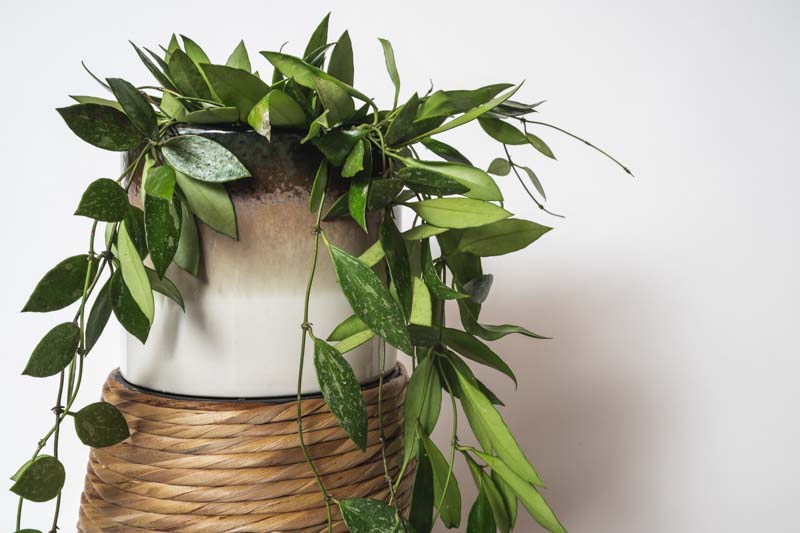Porcelain Flower, Wax Plant, Pink Silver, Silver Pink Vine
Hoya pubicalyx is a captivating species within the Hoya genus, widely appreciated for its stunning flowers and decorative foliage.
Hoya pubicalyx showcases elongated, glossy leaves that vary in color from green to almost black, often adorned with silver flecks. Clusters of fragrant, star-shaped red flowers with pink centers release their sweet fragrance in the evening. Hoya pubicalyx is recognized for its vigorous climbing habit, making it an ideal candidate for trellises or hanging baskets. It is sometimes confused for Hoya carnosa.
Native: Originating from the Philippines, Hoya pubicalyx thrives in tropical climates, comfortably adapting to indoor environments elsewhere, provided they mimic its native habitat’s warmth and humidity. It belongs to the dogbane family (Apocynaceae), along with plumeria, periwinkle, mandevilla, or oleander.
Plant Type and Habit: As an epiphytic perennial (grows on trees), it exhibits both trailing and climbing tendencies, with the capacity to reach impressive lengths when supported. The resilience and adaptability of this evergreen climbing vine have made it a popular choice.
Size: Indoors, Hoya pubicalyx can grow 10-12 feet long (3 to 3.6 meters), with its vine-like stems displaying a lush array of leaves and blooms. Its growth can be directed through pruning and training over supports.
Hoya Flower: The plant is celebrated for its star-shaped flowers, which emerge in clusters of pink, red, or even nearly black hues. These blooms are not only visually striking but also emit a delightful fragrance, particularly at night. It typically flowers from late spring through summer, with adequate light and care encouraging repeated blooming.
Fruit: Following successful pollination, it can produce small, pod-like fruits, a rare sight indoors.
Foliage: Its long, narrow, dark green leaves turn silvery-pink when exposed to sunlight. Their glossy texture and unique patterns provide year-round visual interest.
Hardiness: It is best suited for warm indoor environments and can be grown outdoors in USDA hardiness zones 10-12.
Uses: Hoya pubicalyx is mainly cultivated for its ornamental value, enhancing indoor spaces with cascading vines and charming flowers. It’s also utilized in shaded outdoor gardens in warm climates.
Toxicity: Hoya pubicalyx is non-toxic to pets and humans, making it a safe addition to households with animals and children.
Invasiveness: It is not considered invasive, as it’s mostly grown in controlled indoor or greenhouse environments.
Benefits: Beyond its decorative appeal, it is believed to purify the air by removing toxins, contributing to a healthier indoor environment.

Hoya carnosa (left) and Hoya pubicalyx (right)
Growing and caring for Hoya pubicalyx is rewarding thanks to its stunning foliage and beautiful flowers.
Light: Hoya pubicalyx prefers bright, indirect light. It can tolerate some direct morning or late afternoon sun but avoid harsh midday sunlight, which can scorch its leaves.
Soil: Use a well-draining potting mix. A mix designed for orchids or succulents containing ingredients like perlite, bark, and peat works well to mimic its natural epiphytic environment.
Water: Water when the top inch of soil feels dry. Ensure good drainage to prevent root rot. Reduce watering in the winter months when growth naturally slows down.
Temperature and Humidity: Keep your Hoya pubicalyx in a warm environment, ideally between 60°F to 85°F (16°C to 29°C). Protect it from drafts and sudden temperature changes. This plant enjoys high humidity (40-60%) typical of its native tropical habitat. If your indoor air is dry, consider using a humidifier, misting the plant regularly, or placing it on a pebble tray with water.
Fertilization: During the growing season (spring and summer), fertilize monthly with a balanced, water-soluble fertilizer diluted to half the recommended strength. No fertilizer is needed in the fall and winter.
Pruning: Pruning is not strictly necessary but can help control its size and encourage bushier growth. Avoid pruning off the peduncles (flower stalks), as Hoya pubicalyx will rebloom from these.
Flowering: To encourage blooming, allow the plant to become root-bound and provide adequate light. After blooming, avoid pruning the flower stalks, as Hoya will rebloom on old spurs.
Repotting: Repot every 2-3 years or when the plant becomes root-bound. Use a slightly larger pot to encourage growth. Spring is the best time for repotting.
Propagating Hoya pubicalyx is a rewarding way to expand your collection or share this beautiful plant with others. Here’s how to propagate Hoya pubicalyx through stem cuttings, a simple and effective method:
Choose a Healthy Stem: Look for a healthy, vigorous stem on your Hoya pubicalyx that has at least 2-3 nodes (the points where leaves attach to the stem). Healthy stems are more likely to root successfully.
Cut the Stem: Using your clean, sharp scissors or pruning shears, cut the selected stem, ensuring each cutting is about 4-6 inches long. Make the cut just below a node.
Prepare the Cutting: Remove the leaves from the bottom node or two to prevent them from rotting when planted. This also exposes the nodes, where roots will form.
Apply Rooting Hormone (Optional): Dip the cut end of the stem into rooting hormone. This step is optional but can help encourage root development.
Plant the Cutting: Fill your small pot with the well-draining potting mix and make a hole in the center. Insert the cut end of the stem into the hole, ensuring at least one node (preferably two) is buried in the soil. Gently firm the soil around the stem.
Create Humidity: To create a humid environment around the cutting, you can cover the pot with a clear plastic bag or place it under a propagation dome. Make sure the leaves do not touch the plastic, as this could encourage rot.
Place in Bright, Indirect Light: Position the pot in a location that receives bright, indirect sunlight. Avoid direct sun exposure, which can be too intense for the cutting.
Wait for Roots to Develop: Keep the soil lightly moist but not waterlogged. Roots typically begin to form within a few weeks to a few months. You can gently tug on the cutting to feel for resistance, indicating root growth.
Care for Your New Plant: Once the cutting has established a robust root system, you can care for it as you would a mature Hoya pubicalyx. Continue providing bright, indirect light, moderate watering, and occasional fertilization during the growing season.

Hoya pubicalyx is generally resilient, but like all plants, it may encounter pests and diseases.
Mealybugs: Look for white, cottony masses on stems and undersides of leaves. Remove with alcohol-dipped cotton swabs or apply insecticidal soap.
Scale insects: Hard, dome-shaped pests that attach firmly to stems and leaves, feeding on sap. Their presence can lead to yellowing leaves, stunted growth, and a decline in plant health.
Aphids: These small, green pests suck sap from new growth. Rinse them off with water or treat the plant with neem oil.
Whiteflies: They are tiny, winged insects that feed on plant sap, causing yellowing and weakening of leaves. Combat them by rinsing plants with water, using yellow sticky traps to catch adults, or applying insecticidal soap or neem oil to affected areas.
Root rot: Caused by overwatering and poor drainage. Ensure well-draining soil and allow the topsoil to dry out between waterings.
Gray mold or Botrytis: A gray mold that can affect leaves and stems, particularly in cool, damp conditions. Improve air circulation and reduce humidity.
Leaf Yellowing: Can be due to overwatering, underfeeding, or insufficient light. Adjust care accordingly.
Leaf Drop: May occur if the plant is too dry, too cold, or experiencing a drastic change in environment.
No Blooms: Insufficient light or pruning off the peduncles (flower stalks) can prevent flowering. Hoyas should be mature enough and have ample light to bloom.
Hoya pubicalyx exhibits both trailing and climbing habits, making it versatile for different display methods. With proper support, it can elegantly climb, while in hanging baskets, it beautifully trails.
Hoya pubicalyx is considered a moderately fast grower compared to other houseplants, especially when provided with optimal growing conditions including bright, indirect light, and consistent moisture during its growing season.
To encourage Hoya pubicalyx to bloom, focus on providing adequate light—bright, indirect sunlight is ideal. Ensure the plant is not overwatered, and consider a bloom-boosting fertilizer in spring and summer. Hoyas also prefer to be slightly root-bound to bloom, so avoid over-potting. Finally, maintain high humidity and keep temperatures consistent.
A Hoya plant can live for many years, often several decades, with proper care. These plants are known for their longevity and can become cherished members of your indoor garden for a long time, continuously producing new leaves and flowers with the right conditions.
| Hardiness |
10 - 12 |
|---|---|
| Plant Type | Houseplants, Climbers |
| Plant Family | Apocynaceae |
| Genus | Hoya |
| Exposure | Partial Sun |
| Season of Interest |
Spring (Early, Mid, Late) Summer (Early, Mid, Late) Fall Winter |
| Height |
10' - 12' (3m - 3.7m) |
| Spread |
1' - 12' (30cm - 3.7m) |
| Maintenance | Low |
| Water Needs | Average |
| Soil Type | Loam, Sand |
| Soil pH | Acid, Alkaline, Neutral |
| Soil Drainage | Well-Drained |
| Characteristics | Showy, Evergreen |
| Tolerance | Drought |
| Garden Uses | Hanging Baskets, Patio And Containers |
| Garden Styles | Mediterranean Garden |
| Hardiness |
10 - 12 |
|---|---|
| Plant Type | Houseplants, Climbers |
| Plant Family | Apocynaceae |
| Genus | Hoya |
| Exposure | Partial Sun |
| Season of Interest |
Spring (Early, Mid, Late) Summer (Early, Mid, Late) Fall Winter |
| Height |
10' - 12' (3m - 3.7m) |
| Spread |
1' - 12' (30cm - 3.7m) |
| Maintenance | Low |
| Water Needs | Average |
| Soil Type | Loam, Sand |
| Soil pH | Acid, Alkaline, Neutral |
| Soil Drainage | Well-Drained |
| Characteristics | Showy, Evergreen |
| Tolerance | Drought |
| Garden Uses | Hanging Baskets, Patio And Containers |
| Garden Styles | Mediterranean Garden |
How many Hoya pubicalyx (Wax Plant) do I need for my garden?
| Plant | Quantity | |
|---|---|---|
| Hoya pubicalyx (Wax Plant) | N/A | Buy Plants |
Create a membership account to save your garden designs and to view them on any device.
Becoming a contributing member of Gardenia is easy and can be done in just a few minutes. If you provide us with your name, email address and the payment of a modest $25 annual membership fee, you will become a full member, enabling you to design and save up to 25 of your garden design ideas.
Join now and start creating your dream garden!
Create a membership account to save your garden designs and to view them on any device.
Becoming a contributing member of Gardenia is easy and can be done in just a few minutes. If you provide us with your name, email address and the payment of a modest $25 annual membership fee, you will become a full member, enabling you to design and save up to 25 of your garden design ideas.
Join now and start creating your dream garden!